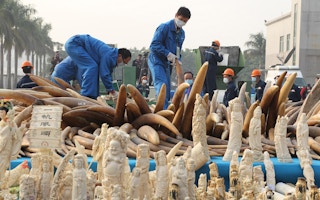China on Monday destroyed six tonnes of confiscated ivory for the first time, a landmark move that the United Nations Environment Programme duly applauded.
The international organisation, which has four decades of wildlife and forest conservation work, has been increasing global efforts to end the illegal trade of elephant tusks.
Large-scale seizures of ivory destined for Asia have more than doubled since 2009 and even reached a record high in 2011, said UNEP.
As such, UNEP executive director and UN under-secretary general Achim Steiner congratulated China and the State Forestry Administration for their initiative to squash the illicit trade that is tied to African elephant killings.
“
The largest remaining land mammal on the planet is facing one of the greatest crises to hit the species in decades
Achim Steiner, UNEP executive director
Chinese authorities fed the ivory stockpile into crushing machines at the public destruction event in Dongguan, a city that is reportedly a major hub for ivory trade.
Steiner said: “The largest remaining land mammal on the planet is facing one of the greatest crises to hit the species in decades.”
About 47,000 animals were killed in Africa in 2011 and 2012, according to the Convention on the International Trade in Endangered Species of Fauna and Flora (CITES). If this is not stopped and current poaching rates continue, African elephants could eventually become extinct, they added.
In the continent, Central Africa is particularly where the killings are more rampant, UNEP noted. The rates are twice the continental average, they pointed out. It estimates that there were more than 17,000 killings in 2011 at monitored sites alone, but this could be in higher in actual count.
Criminal networks and syndicates are behind this wildlife crime and the illegal trafficking of ivory between Africa and Asia, said UNEP.
The UN, animal welfare groups and the rest of the international community aim to step up actions to address this issue. Along with this latest ivory destruction, the Philippines also crushed a five-tonne ivory stockpile in June 2013, while Gabon burned more than four tonnes in 2012.
In August last year, two NGOs – the Environmental Investigation Agency and Humane Society International – also called on Yahoo! Japan to stop the sale of elephant ivory products on their website.
In a report released last March, entitled Elephants in the Dust: The African Elephant Crisis, the UNEP, CITES, the International Union for Conservation of Nature (IUCN), and the Wildlife Trade Monitoring Network (TRAFFIC), provided an insight into the entire illegal ivory trade chain and the actions need to ensure elephant protection.
Some measures listed by UNEP include:
- the strengthening of national legislative frameworks and law enforcement across the supply chain of illegal ivory
- training enforcement officers to use intelligence networks and innovative techniques to track illicit trade
- better international collaboration across range states, transit countries and consumer markets
- and, identifying syndicates, fighting underlying corruption and reducing consumer demand.
Steiner underscored that international cooperation and critical public awareness are the means forward to end this crime against biodiversity.
“These efforts need to be stepped up and strengthened to produce the desired results,” he noted.

















